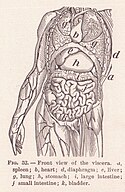
Back قائمة مصطلحات تشريح المواضع (طب) Arabic Анатомични термини за местоположение Bulgarian Termes anatòmics de localització Catalan Anatomické směry Czech Anatomiske begreber Danish Anatomische Lage- und Richtungsbezeichnungen German Τοπογραφική ανατομική ορολογία Greek Terminología anatómica de localización Spanish Anatoomilised asenditähistused Estonian بیان جهت در آناتومی Persian
 |
| This article is part of a series on |
| Anatomical terminology |
|---|
Standard anatomical terms of location are used to unambiguously describe the anatomy of animals, including humans. The terms, typically derived from Latin or Greek roots, describe something in its standard anatomical position. This position provides a definition of what is at the front ("anterior"), behind ("posterior") and so on. As part of defining and describing terms, the body is described through the use of anatomical planes and anatomical axes.
The meaning of terms that are used can change depending on whether an organism is bipedal or quadrupedal. Additionally, for some animals such as invertebrates, some terms may not have any meaning at all; for example, an animal that is radially symmetrical will have no anterior surface, but can still have a description that a part is close to the middle ("proximal") or further from the middle ("distal").
International organisations have determined vocabularies that are often used as standards for subdisciplines of anatomy. For example, Terminologia Anatomica for humans and Nomina Anatomica Veterinaria for animals. These allow parties that use anatomical terms, such as anatomists, veterinarians, and medical doctors, to have a standard set of terms to communicate clearly the position of a structure.
© MMXXIII Rich X Search. We shall prevail. All rights reserved. Rich X Search